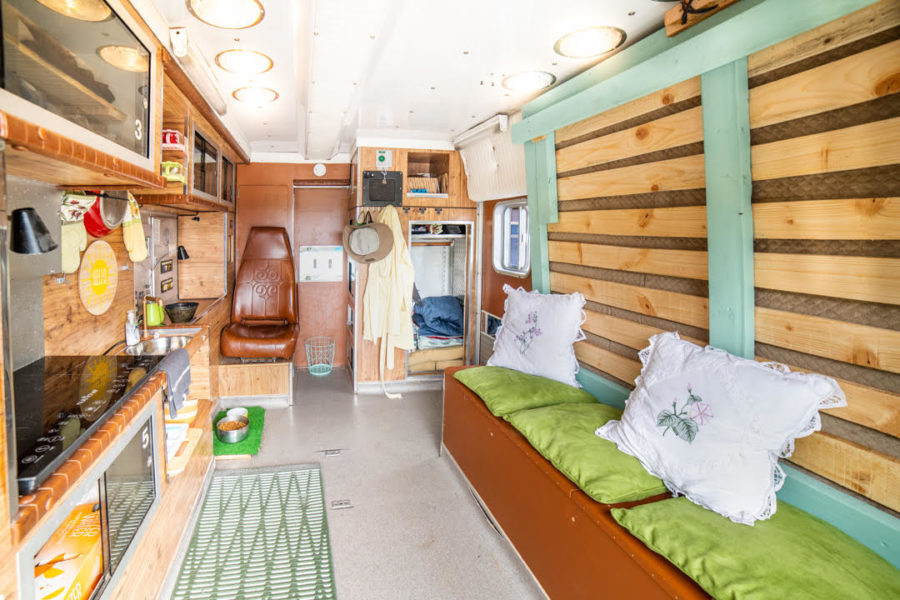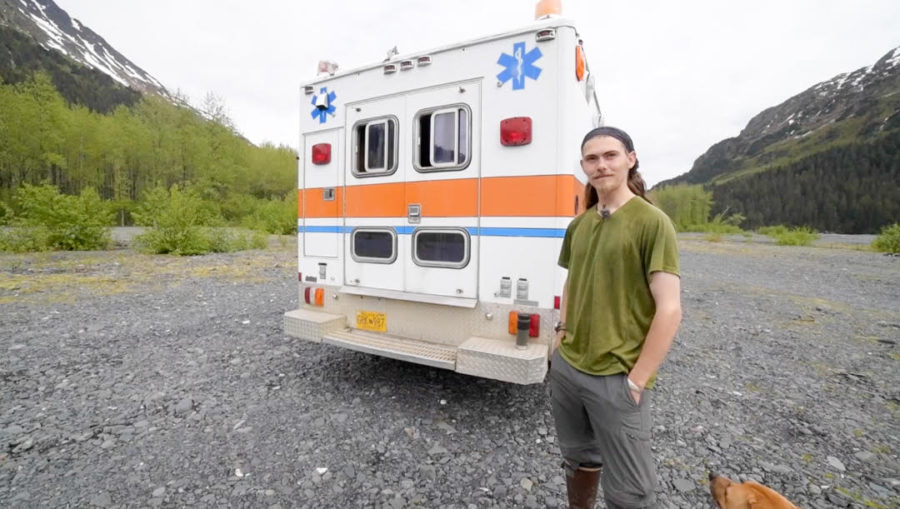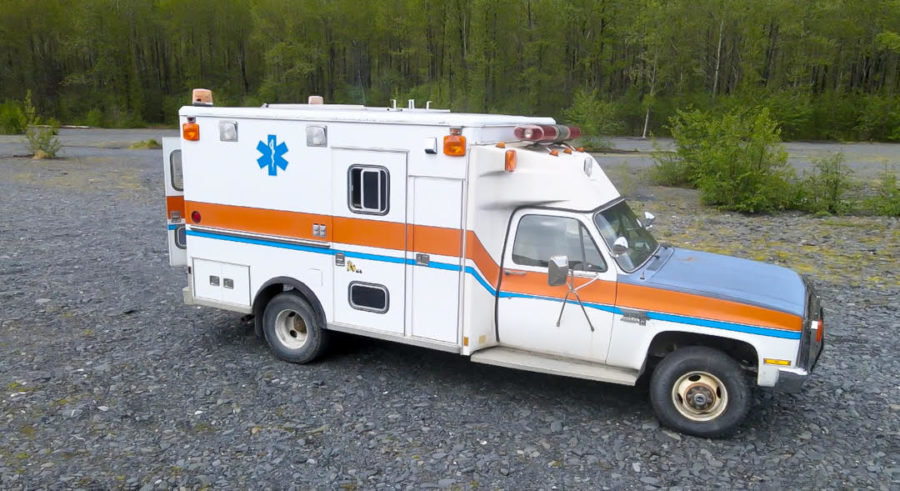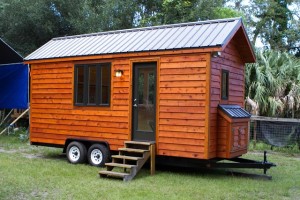This post contains affiliate links.
Meet Dritzz. He and his dog, Cedar, were tent-living in Alaska when he came across an amazing deal on an 1986 4-wheel drive Ambulance with just 35,000 miles.
He put about $2k into making it a home. His girlfriend wanted a kitchen and a library, and you’ll find both inside his build. There’s an induction cooktop, Murphy bed made from locally-sourced lumber, and plans for an indoor shower down the road.
Enjoy the Tiny Home Tours video at the end of the post.
Don’t miss other interesting tiny homes like this one – join our FREE Tiny House Newsletter for more!
Wait Until You See the Murphy Bed!

Images via Tiny Home Tours
Before the Ambulance, Dritzz was living in a tent.

Images via Tiny Home Tours
It needs some mechanical upgrades, but works well enough for now.

Images via Tiny Home Tours
VIDEO: $7K Budget Ambulance Tiny House w/ Clever Murphy Bed
Learn More:
Related Stories:
- Jake’s Japanese Ambulance Bus Conversion w/ Fold-Down Stage
- 1997 E450 4×4 Diesel Ambulance Conversion With A Shower!
- Former Paramedic Firefighter in his Overlandbulance
Our big thanks to Allison & Erika of Tiny Home Tours/Youtube for sharing! 🙏
You can share this using the e-mail and social media re-share buttons below. Thanks!
If you enjoyed this you’ll LOVE our Free Daily Tiny House Newsletter with even more!
You can also join our Small House Newsletter!
Also, try our Tiny Houses For Sale Newsletter! Thank you!
More Like This: Tiny Houses | Motorhomes | Bus Conversions | Ambulance Campers | Ambulance Conversions | Conversions | Vehicles
See The Latest: Go Back Home to See Our Latest Tiny Houses
This post contains affiliate links.
Natalie C. McKee
Latest posts by Natalie C. McKee (see all)
- eBoho XL Available Now w/ $9.5K Discount - April 18, 2024
- Mi Casita Tiny House: Custom Build by Modern Tiny Living - April 18, 2024
- 967 Sq. Ft. Home Plans with RV Garage! - April 18, 2024






I am wondering what kind of gas mileage one can expect from this rig? Im guessing 5 miles per gallon.
that for me is the only drawback.
nice that so much electronics were already present and the low mileage……..
ronn,
.
2003, my Very Significant Other got sick.
Naturally, as you might expect, we acquired a 1997 Ford CF8000 commercial truck to convert to our concept of an ExpeditionVehicle.
We completed our conversion — while selling everything — in less than a week and hit the road from Oregon with the vague goal of ‘south!’.
.
Twenty-four months twenty-four thousand miles around South America.
Alaska, Panama, all over north and central America.
Summers up rough logger tracks to remote mountain lakes, winters on isolated Baja beaches.
.
As we load groceries or laundry in a parking-lot, folks often express their desire to travel more… but are terrorfied of investing in fuel.
Our response:
* “What kind of fuel mileage does your apartment get?”
thank you for your reply- but am looking for an honest answer…………
ronn,
.
Your point is valid, although our experience is different.
.
Some folks in our extended family of caravans move multiple times a week.
Their fuel and vehicle investments are different compared to us.
We set a spot, knowing the seasons.
Some months, we travel less than a hundred miles.
.
Travelling to a house-sitting gig or another of our part-time workkamp gigs, we are in the slow-lane at 52mph.
We rarely get better than 14mpg.
.
With nearly two decades full-time live-aboard, our Cummins 505ci has no computers or Exhaust Fluid injectors to provide entertainment.
Bomb-proof, our Cummins needs only Preventative Maintenance, the usual oil/filters, belts, hoses.
After a decade-and-a-half, our Allison 3060 automatic tranny got fresh fluid/filters a couple-three years ago.
.
Our cost-of-thriving is a tiny fraction of a stand-still house.
An aside:
* house-sitting, we get the impression most folks pay expensive storage for spare bedrooms to pile boxes of stuff they ‘hope to use someday’
.
An added bonus to mobile living:
* if rioters throw a tantrum, we can drive over to spectate
* a flood or volcano or hurricane, we can move over to enjoy the show
.
As you can imagine, with all this fun going on, our investment in fuel is tiny — unnoticeable — compared to the interesting experiences.
.
One point we do different from the gent in today’s video:
* we use induction hot-plates instead of a permanent stove-top
We prefer cooking outside, so we set one or more hot-plates on a picnic-table or on the shore with an extension-cord back to the rig.
(We are exploring (that word again!) ‘portable solar generators’ such as Jackery or Bluetti, but are waiting for the industry to mature before investing.)
As you can imagine, with a dedicated personal creation-zone, each cook has plenty of elbow-room to create culinary masterpieces.
Then, during clean-up, the hot-plates slide back into their cubbies.
.
Stand-still house folks often wonder at our ability to pack everything we need into an interior three paces across by seven paces long… everything for two adults (plus a frequent yummy third!) and two RedHeelers.
Everything goes in clear flip-top crates under the permanent bed.
.
For a physical and visual sense of openness, we have no cabinets above waist-level.
.
Speaking of our bed, we refuse to fuss with fussy furniture.
Instead of re-arranging a jig-saw puzzle each morn, I prefer to eat my bacon in peace.
For our bed, we fabricated a permanent steel frame; the platform is expanded steel (similar to a stout window-screen) for under-mattress ventilation.
.
During today’s video, did you see any holes in the roof?
Holes in the roof tend to combine rain with gravity in a devious plot to drench everything inside.
My favorite — a sky-light over the bed to watch the stars.
I tend to shy away from putting holes in a functional roof…
Have we ever featured your rig? It sounds awesome!
He said in the video 7 mpg
Wow! Living in a tent in Alaska! Sounds scary dangerous! I’m glad you found this amazing ambulance in which to dwell, and you did a great job outfitting it to make a cozy home. It’s beautiful! The bed is cool! I wish you many happy and safe trails.
There’s always trade offs, for nomadic living the usual most significant is the size and level of comfort of living space versus weight and fuel efficiency. Bigger also tends to be less aerodynamic and compound the effect on lowering fuel efficiency.
While usage is also a factor, like typically exceeding 50MPH starts to lower fuel efficiency to the point that you can assume that each 5 mph you drive over 50 mph is like paying an additional $0.22 per gallon for gas.
Conversely, going slower can give an average savings, assuming drivers are willing to slow down 5 to 10 mph, on fuel costs by about $3.15 per gallon. But, of course, this effects how long your trip will be and can run into other concerns like arriving with enough time to find parking, etc.
So it’s often about finding balance and what can work for you and your priorities. Some people will need more living space than others, others may need fewer conveniences, etc.
Nomadic living ranges from small cars to massive trailers towed by semi trucks.
I’d only suggest you try it first before committing, rent a similar size RV and see if it can work for you and then decide if the trade offs will work for you or not…
thank you. I am speaking from the point of which vehicle to start with. I plan on doing extensive traveling
and might be better off starting with something like a sprinter, for example.